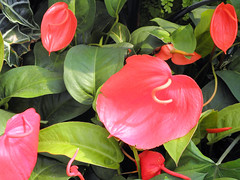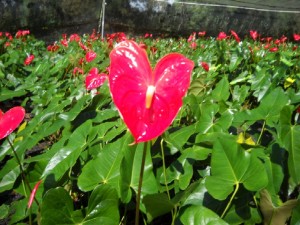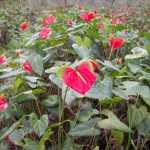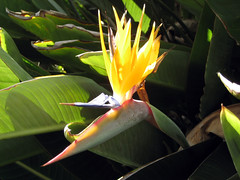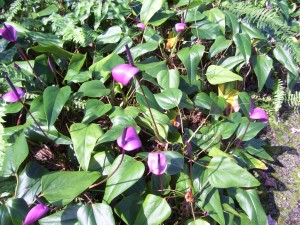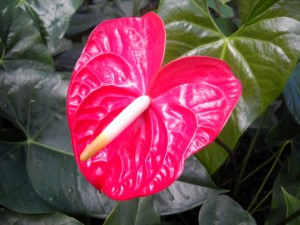Midori Anthurium Picture
This is a picture of one of our Midori anthuriums. Feel free to use this picture on your website or share it with your friends on facebook. All I ask is that you include a link back to our website.
Embed Code
Anthurium Scherzerianum Plant Care
Scherzerianum (or Pig-Tail Anthurium) are a beautiful breed of anthurium plant that produces red, orange or pink flowers. What sets them apart from Andraeanum is their spadix. They have a curly spadix, rather than a straight one like Andraeanum. Since they are closely related to Andraeanum, Anthurium Scherzerianum Plant Care is really not very different than what is required for Andraeanum.
I suppose that the main difference between the species is that Scherzerianum is a bit better adapted as a houseplant so they are in fact a little easier to care for.
Temperature
The ideal temperature for it is 80 degrees. Ideally, it should not be exposed to temperatures below 60 degrees or above 90 degrees. Temperatures below 60 degrees will hinder growth and flowering, while temperatures above 90 degrees can cause damage to flowers and leaves. Freezing temperatures are to be avoided at all costs, since exposure to frost can be deadly.
Light
Bright, indirect sunlight is best. But direct exposure to midday sun can burn leaves and foliage, so make sure that it is never exposed to strong, direct sunlight. If your plant is near a window with direct sun, cover the window with a thin, filmy curtain to block a portion of the light. If your plant receives too little light, it may stop flowering. A tell-tale sign of insufficient light is a plant that produces a lot of dark green leaves and no flowers.
Potting Soil
Any loose, well drained soil will work well. If you have access to volcanic cinder, you can use it. If not, you can use a mix that has bark, moss and perlite. The key is to make sure that your potting soil drains well. Excessive moisture can cause root rot and other problems that may harm your plant.
Watering
Water your plant regularly, but make sure that the water drains out of the pot quickly. In the rainforest, these plants grow up the side of trees. Despite receiving daily water from rain, their roots are never soaked in water because the water drips down the side of the tree and away from their roots. Since your plant is in a pot, you need to make sure that all of the water drains out of the pot and the potting soil dries slightly, but not completely, before watering again.
Humidity
Humidity should be high, but not excessive. Somewhere around 70 to 80% is ideal. Any higher and fungal issues may occur. Down to 50% is generally fine. But you may want to mist the leaves once and a while. Mist the leaves in the morning and make sure that they dry by the evening to prevent fungal problems. If they don’t dry by the evening, this means that your humidity is more than enough and you don’t need to mist your plants. At this level of humidity good air circulation is essential to prevent the growth of fungus.
Red Anthurium Flowers and Plants
Our red anthurium flowers are the perfect gift when you want to express a burning passion for that special someone in your life. Red is the color of passion and love, and it is also the color of bravery, strength and courage under fire. We sell large red anthuriums for only $3.25 per stem. We will soon be offering top cuttings of red Princess Lily Anthuriums for $29 per plant.
Click Here To See Our Catalog.
Red Anthurium Flowers
A number of years ago, before plant breeders started working with them, anthuriums were much plainer than they are now. They produced smaller, less colorful flowers. Thanks to the effort of plant breeders, today, we have a plethora of shapes, colors and sizes. One of the original colors produced by the plant breeders is red. Because of this, red anthuriums were one of the first commercial varieties of anthurium flowers.
Red Anthurium Plants
There are a number of varieties of red anthurium plants. Varieties include: Kozohara, Ozaki, Starlight Red, Princess Lily and New Pahoa Red. The Kozohara and Ozaki are among the older varieties and the other varieties are slightly newer. The major weakness of the red varieties is that the majority of them are highly susceptible to bacterial blight, though the University of Hawaii and other breeders have been hard at work at creating blight tolerant varieties.
Anthurium Blight
Several decades ago the emergence of the bacterial blight nearly wiped out the industry because the majority of the flowers grown were red and hence highly susceptible to the blight. Fortunately, better sanitization practices and the cultivation of blight resistance varieties have allowed red flowers to stage a comeback.
Red Anthurium Care
Aside from taking precautions against the blight, caring for red varieties is fairly similar to other varieties. And assuming that you are raising only a few potted plants in your home, you probably don’t even have to take precautions against the blight; provided that your plants aren’t located right next to each other and you don’t visit any anthurium farms.
Essentially, find a warm area for your red anthuriums. Next, make sure that this area receives bright, but indirect sunlight, so that your plant won’t be burnt by the sun. Then pay close attention to how you water them. Give them a little water everyday and make sure that the excess water is allowed to drain out of their pots. Not allowing water to drain is the second biggest reason for dead plants. Of course the first reason is not remembering to water them at all.
So this is really all you need to know about red anthurium plants. They are very easy to care for. They are much like regular anthurium plants. They are one of the oldest commercial varieties. And they have a susceptibility to blight, but this is not a big deal if you are not raising them in commercial quantities.
Tropical Flower Names
Not only do tropical flowers look exotic, but many also exude evocative fragrances that can evoke memories of sultry nights spent in faraway island paradises. Here are the names of some of my favorite tropical flowers.
Anthurium
There are many different species in the anthurium family. The most popular flower variety is Anthurium Andreanum which produces heart shaped flowers of many different sizes and colors. Some popular names include: Flamingo Flower, Obake, Midori, Ozaki, and Princess Lily.
Torch Ginger
The torch ginger, or Etlingera elatior, originally comes from Asia. It is pink, red or yellow-orange in color and it kind of looks like flames coming off a torch, hence its name. The seed pods of certain varieties may be used in cooking fish dishes in some parts of Asia. Sometimes the flower buds are also used in cooking. But I’d much rather look at these beautiful flowers than eat them. Sometimes they can grow up to fifteen feet high.
Bird of Paradise Flower
These flowers are originally from South Africa. It received its name because the flower it produces looks like a bird of paradise, which is a species of bird found in New Guinea.
Heliconia
These are a genus of roughly two hundred species that are found in the pacific and in South America. They produce bright red and orange flowers and when they are not in bloom they sort of resemble plantains or banana plants. Some variety names include: Yellow Christmas, Red Holiday and Yellow Dancer.
Tulip Anthurium
These types of anthuriums have a shape that may remind you of tulip flowers. These varieties were produced by crossing Amnicola with Andraeanum. They may come in white, pink, red and purple. Unlike other anthuriums, several varieties have a sweet, pleasing fragrance.
Ginger
There are many different varieties of ginger flowers like torch ginger, red ginger and pink ginger. And I have not even begun to scratch the surface. The roots of some varieties of ginger plants are also used to make the ginger spice that is used in cooking.
Protea
This variety of flowers was named after the greek god Proteus, who could change form at will. It is a very ancient variety of plant that originated over 300 million years ago and is originally from South Africa. It has feather petals that could easily be mistaken for feathers. Some common names include: King, Pink Ice and Carnival.
Plumeria
The plumeria originated in Central and South America. It produces a flower with a very lovely scent. In Hawaii, it is frequently used in lei-making, because it is both beautiful and it smells good.
Orchid
Orchids are probably the most popular tropical flower in the world. They are grown by millions of people. There are thousands of species of orchids and many more are being created each year. They can grow just about everywhere, except on glaciers. There is even an edible variety of orchid: you may know it as vanilla.
Obake Anthurium
“Obake” means “change” or “ghost” in the Japanese language. These flowers usually consist of two or more colors. Most of the time one of the colors is green and the other colors may be orange, red, pink or white. Obake anthuriums usually produce some of the biggest anthurium flowers and they are often elongated in shape and very curly or wavy. They are usually the fanciest and most pricy type of anthurium flowers, but they are well worth every penny.
Red Ginger
Red gingers (which are also known as Alpinia purpurata) are another plant from Asia, Malaysia to be specific. It produces red flower (of course) and it can also be found growing in Hawaii and South America. The red cone is commonly thought to be the flower, but it really is consists of bracts which are reddish colored modified leaves. The real flowers are whitish and form inside of the reddish cone.
Pink Ginger
Pink ginger looks a lot like red ginger, but it is pink. (Now this is a big surprise.) They are very closely related to red ginger and come from the same place, Asia. It belongs to the same family as edible ginger.
Hibiscus
The yellow hibiscus is the state flower of Hawaii. This genus of plants grows through out the world, where ever tropical climate conditions exist. Most of the time it is grown as an ornamental plant, but a few varieties are used to make tea.
Pink Mink Protea
These flowers come from South Africa. Their petals resemble pink feathers and they look quite exquisite. Did you know that Proteas are the national symbol of South Africa? They also grow very well in Hawaii, but the emissions from the Kilauea volcano have been causing heavy damage to the crops of protea farmers in Kau. So this has been hurting the supply of proteas from Hawaii. Proteas also make excellent dried flowers. You can hang them upside down and let them dry out and they will continue looking almost as good as when you first got them.
Pincushion Protea
These interesting flowers are also from South Africa. Based on their name, I’m sure that you can guess what they look like. They look like pincushions with pins sticking out of them. This is probably the perfect flower for someone who likes sewing.
Anthurium Gift Ideas
Anthurium flowers and anthurium plants from Hawaii make excellent gifts. Anthurium flowers are some of the longest lasting flowers around. Some varieties can last more than a month. Anthurium plants are sturdy and easy to grow, and they lend a great tropical feel to any room.
Hawaii has a long history with anthuriums. Anthuriums were brought here back in the late 1800s and the anthurium industry officially began around 1950, which is just a decade before Hawaii became the fiftieth state.
Complete anthurium arrangements can be ordered from most flower shops. But if you are willing to arrange the flowers personally, for the person you are giving them to, you can save some money by ordering loose flowers directly from farms here in Hawaii. They will arrive carefully packed in a box, separated by layers of shredded paper to cushion them while they are in transit. Make sure that they are shipped to you using either first day or second day air. Anything longer than this and they may not arrive in great condition. Also, make sure that you are home to receive them, when they arrive.
Anthurium plants can also be purchased from a variety of locations. Sometimes you can find them at a local garden shop or at a nursery that is near you. But you probably won’t be able to find the full set of varieties that you could find if you ordered them directly from Hawaii. Nurseries in Hawaii offer a greater selection, because many of the more interesting varieties were developed here.
As far as what cultivars to buy, if the recipient of your gift knows nothing about gardening, I would recommend sticking with Andreacola or Amnicola cultivars as they are easier to grow. But if the recipient has some gardening skills, an Andreaenum cultivar would make an excellent gift. It produces bigger flowers and comes in a wider assortment of shapes and colors.
Purple Anthurium: An Anthurium Andraeanum and Amnicola Hybrid
Purple anthurium plants produce a stunning tulip shaped flower in a very pleasing shade of purple. As you may already know, originally, anthuriums didn’t come in very many colors. In fact most of the colors that you see today were developed after the 1940s. Purple is a color that is even newer than that. I believe that it was first developed sometime after 1980.
Purple Anthurium Origins
This flower was created by crossing anthurium andraeanum with amnicola to produce a hybrid named andreacola. Andreacola appears to have inherited the best traits of both of its parent species. From the amnicola it received its ability to produce tulip shaped flowers, its compact size and its resistance to the bacterial blight. From the andraeanum it received an ability to produce larger flowers and a multitude of colors, which, of course, includes purple.
Tulip Anthurium Cut Flowers
As a cut flower, they are perfect for smaller arrangements because they are slightly smaller than regular anthuriums. They have a great vase life and will last for several weeks. They look great when arranged with pink and pastel green anthuriums or when arranged with white orchids. Another thing that sets this variety apart is that sometimes these flowers will have a very pleasant scent. Just about all other anthurium flowers are unscented, but sometimes these flowers have a great fragrance.
Excellent House Plants
They also make excellent houseplants. They are more compact than other varieties so they take up less space in your house. Furthermore they are even hardier than other varieties, so they are even easier to care for. The fact that they are blight resistant is another positive factor. This makes for one less thing that you have to worry about.
Ordering Tips
If you do decide to order one of these plants, try to order during a time of the year where the average daily temperature is 70 degrees and the range of temperatures is narrow. Temperatures that are too hot or too cold, during shipping, may harm these plants while they are in transit.
Taking Care of Your Purple Anthurium Plant
After you order, aim to have a spot for your new plant set up before it arrives. The ideal location has a number of characteristics. First, the temperature should be near 70 to 80 degrees and it should not fluctuate much from this ideal. Second, this spot should be well lit but it must not receive direct sunlight. Direct sunlight can burn your plant. Third, high humidity is ideal, but you can compensate for low humidity by misting your plant with water every day.
As far as caring for your new plant, the main this is: remember to water it regularly. Ideally, you should water it everyday. This is what wild anthuriums are accustomed to receiving in the rain forest, but you must also make sure that all of the water drains away from the roots of your plant rapidly. If the roots remain in contact with water for too long they can suffer root rot and this can harm your plant.
Anthurium Flowers and Plants
ANTHURIUMS are one of the most beautiful flowers in the world. ANTHURIUM FLOWERS are produced by ANTHURIUM PLANTS, which are members of the genus ANTHURIUM. This genus consists of over eight hundred ANTHURIUM SPECIES and hybrids like OBAKE ANTHURIUM. ANTHURIUM CARE is easy and consists of finding the right place to put them and watering them properly. HAWAII is one of the first places in the world to grow anthuriums commercially.
Anthurium Farming: How Anthurium Growers Raise Anthurium Flowers
In Hawaii, growing anthurium flowers is a big business. Anthuriums are grown on more than two hundred commercial farms. Some of these farms have been in business since the 1950s, which was the decade that farmers first started growing anthuriums commercially. Keep reading and I will describe the techniques that these farms use to grow massive quantities of anthurium flowers.
The first step in growing these flowers commercially is building a shade house. The purpose of the shade house is to provide shade to the plants that will be grown in it. The reason why shade is vital to growing anthuriums is that these plants would tend to get burned by the sun if they were to be grown in direct sunlight. To build a shade house, the parcel on which it is going to be built must be cleared and graded with a bulldozer. After the land is leveled off, galvanized pipes are set in place. These pipes are used as columns to support the cables and shade cloth that are used to construct the shade house.
After the shade house is completed, volcanic cinder or other growing media is distributed on the ground of the shade house using tractors. The cinder normally comes from volcanic cinder cones and is brought to the farm in large dump trucks. Usually a layer of cinder about two feet thick is placed on the floor of the shade house.
Once the cinder is in position, anthurium plants are acquired. They can originate from top cuttings of more mature plants in other parts of the farm or they can be the result of vegetative propagation. They are then planted in the shade house.
Usually, Hawaii’s frequent rain showers provide enough moisture for the plants. But, when the rainfall is insufficient the anthurium plants may be watered through overhead sprinklers.
Aloe Care: Simple Tips On How To Care For Aloe Plants
And now, for a brief break from our usual anthurium related fare, here is a post on aloe care…
There are many different varieties of Aloe plants. They range in size from one inch to two feet across. Most species are from Africa and the most popular variety is Aloe Vera, which is often used for treating sunburns. Aloe plants are almost 95% water so freezing weather is very harmful for them. If you live in an area that freezes, you will have to grow your plant indoors. Here are my simple guidelines for aloe care. If you follow them, you should have little trouble keeping your plant alive.
Pot your aloe in a loose soil that drains well. A good soil to use is a cactus mix or you can use a regular potting soil by adding extra sand or perlite to it. You don’t need a huge pot to grow an aloe. An eight inch plant should have little problem growing in a four inch pot.
Put your plant in a place that receives a lot of sun. It is somewhat of a desert plant and it can handle all of the sun that you can throw at it. Either put it near a sunny window or put it outside. But if you put it outside make sure that the temperature never falls below freezing. Frost can kill your plant.
Make sure you don’t over-water it. It should go about two weeks between waterings and the soil should be allowed to dry out. During the winter, your plant’s metabolism will slow and you should reduce the amount of water that is provided. Fertilize it once or twice a year, but use half of the recommended dose on the label. These plants don’t need as much nutrition as other plants.
When it is time to repot, use a wider, rather than a deeper, pot. The roots of an aloe tend to spread out rather than go deeper. If your plant has produced offshoots, you can also use repotting as an opportunity to propagate your aloe by planting the offshoots into pots of their own.
Anthurium Arrangements: A Few Tips
Anthurium flowers are excellent flowers to use in floral arrangements. They look great and they last a long time. They will outlast just about any other flower that is in the arrangement. Here are my thoughts on anthurium arrangements.
These flower arrangements are great for many different types of occasions. I have seen them used for holidays, birthdays and office parties. In Hawaii, they are commonly used for weddings, funerals and, of course, for luaus. And if you are having a tiki party, you have to have them; I think that they are almost mandatory.
These flowers work well with other tropical flowers and foliage. White or blush colored ones work well with green ti leaves. Red ones blend nicely with red ti leaves. They also look great when arranged with ginger or orchid flowers. And larger anthuriums look great with bird of paradise flowers.
There are two ways to buy anthurium arrangements. You can get them through your local flower shop, either by visiting them in person or by buying through a cooperative that works with local flower shops like FTD. Or you can buy them online directly from where they are grown. If you choose the former, you will usually receive a fully assembled arrangement. While if you choose the latter, you will typically receive loose flowers that you will have to arrange by yourself.
It’s actually very easy to arrange these flowers by yourself. When you receive them, clip off half an inch from the end of their stems. This will clear any blockages and allow them to absorb water. Then place them in a container of water and mist them with water from a spray bottle. Next set a block of floral foam in the container that you are going to display them in and add water. Take the tallest flower and press it into the foam near the center and work your way outward with smaller flowers, so that the tallest flowers are in the center and the smallest are on the sides.


